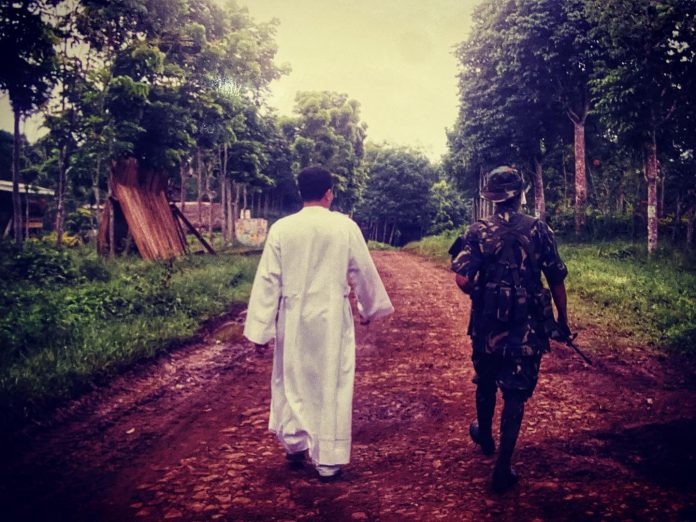How do you build a community of disciples? This is the topic of the whole discourse of Jesus in chapter 18 of the Gospel of Matthew. Today we are reading a portion of this chapter on community building. It is focused on one of the most common problems that all human communities have to deal with: CONFLICT MANAGEMENT.
The key to the whole discourse is the last line in today’s Gospel reading: “For where two or three are gathered together IN MY NAME, there I am in the midst of them.” Matthew is telling us plainly that the community that we build when we come together in the name of Christ is a living representation of Christ himself. In the language of Paul: the CHURCH IS THE BODY OF CHRIST.
To be Church is to gather “in the name of Christ”. It is to belong to an organic unity, it is to be parts of one body. You cannot hurt a fellow member without hurting yourself too because you are connected to each other as one body. It is to belong to a family whose members are related to each other, not just by blood but by the bond of the Holy Spirit in which we have been immersed, meaning, baptized. Through this bonding, we are supposed to grow—from members of human families into members of God’s family.
One of the most ancient practices in early Christianity was the reference to fellow members of the Christian community as “brothers and sisters”. And so the reading today about conflict management begins with a presupposition that you have the duty and obligation to do something about conflicts in the community because YOU ARE NO STRANGERS TO EACH OTHER; YOUR ARE FAMILY. IN THE NAME OF CHRIST, YOU ARE BROTHERS AND SISTERS, SONS AND DAUGHTERS OF THE SAME HEAVENLY FATHER.
“If your brother or sister has wronged or offended you, go and bring it up to that person, but let it be between you and that person alone.” Don’t post it in the social media. That’s the surest way to destroy a relationship. Or seek the help of one or two persons whom he might be more disposed to listen to.
In the earlier part of the Gospel, in the Sermon on the Mount, Jesus gives a commentary on the commandment against murder. There he advises his disciples to learn to manage conflicts from their very onset if they do not want them to lead to the worse sin of murder. He suggests that anger is the most common root cause of murder. And so, he says in Matthew 5:23-24 “Therefore, if you bring your gift to the altar, and there recall that your brother or sister has anything against you, leave your gift there at the altar, go first and be reconciled with your brother or sister, and then come and offer your gift.”
One of the seven Sacraments of the Catholic Church has to do with practical tips on how to do conflict management. We call it THE SACRAMENT OF RECONCILIATION. It contains four important elements of conflict management, or the steps needed for reconciliation to be possible: CONFESSION, CONTRITION, PENANCE, & ABSOLUTION. Although we sometimes relate the sacrament to Confession and Penance, it is important to note that the sacrament is not complete without the other aspects.
In plain language, TO CONFESS simply means to admit our shortcomings, to have the humility to own up to our actions—both the wrong that we should not have done, and the good that we should have done. The second element, CONTRITION, simply means being sorry for what one has admitted. But isn’t it enough to admit it? Does the admission not presuppose contrition already? Well, you see, not all people who admit their wrongdoing are necessarily feeling sorry about it. Some even have the gall to say, “Yes I did it. So what?”
And what about PENANCE? Penance is simply an effort to voluntarily MAKE UP for the wrong that has been done. I may not be able to undo what has been done, but I can express a concrete gesture or effort to make amends, a gesture that shows the sincerity of the penitent. The Gospel calls it the aspect of BINDING, meaning holding ourselves accountable for the wrong that we have done.
And then the fourth element is ABSOLUTION. It is described by the Gospel as UNBINDING—both on earth and in heaven, meaning, both before fellow human beings and before God. It is a graphic description of what forgiveness does—both for the offender and for the offended one—IT LIBERATES; IT HEALS.
Most Catholics don’t realize what a timeless treasure this sacrament is. In fact it can be applied to conflict management on all levels: in relationships, in families, in communities, in societies, or even among nations that are in conflict with each other.
Unfortunately, reconciliation, is not possible for people with calloused or hardened consciences. How can we have reconciliation in our country if so much wrong is happening but nobody has the humility to admit them or own up their wrongdoing, even when they are found out already? Or even feel sorry about them or show the readiness to make an act of reparation for them?
When none of these steps is possible, does that mean we are doomed? Not really. That is when God plays his last card. For the love of sinners, God prepares to suffer, die and descend into hell for our redemption. Hopefully, only the sight of this ultimate sacrifice of him who loves us unconditionally can raise dead consciences back to life and make reconciliation possible.
“Conflict management” is the homily of Bishop Pablo Virgilio David of Kalookan for Wednesday of the 19th Week in Ordinary Time, 12 August 2020, Matthew 18:15-20.









